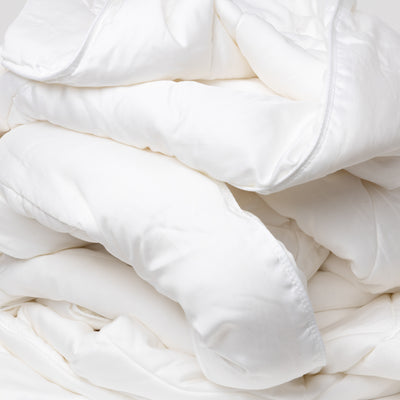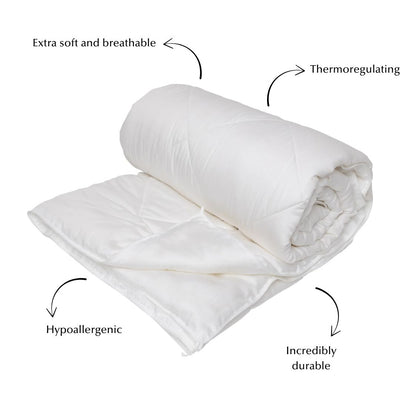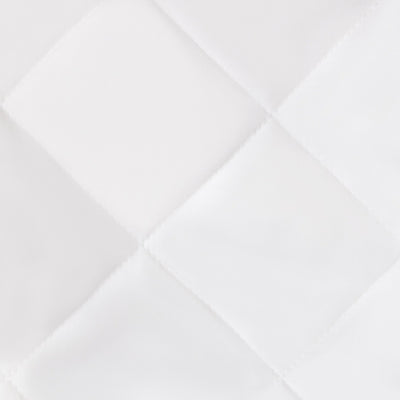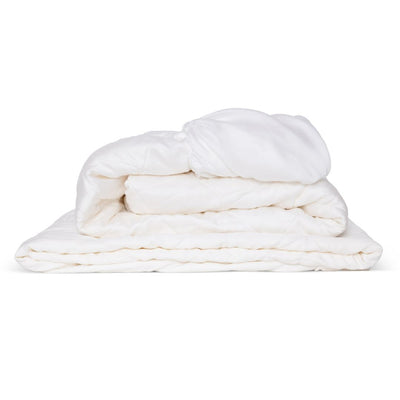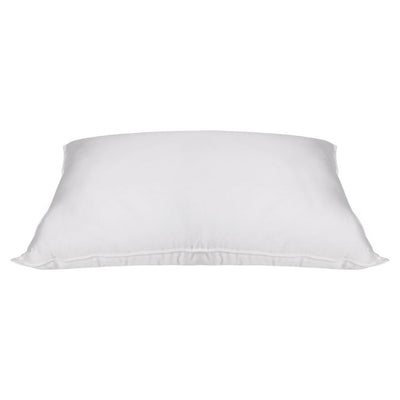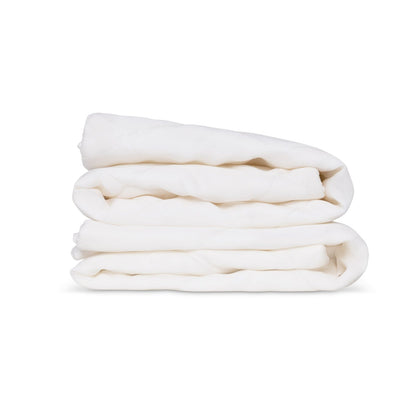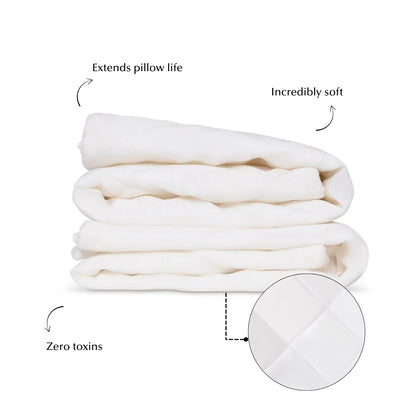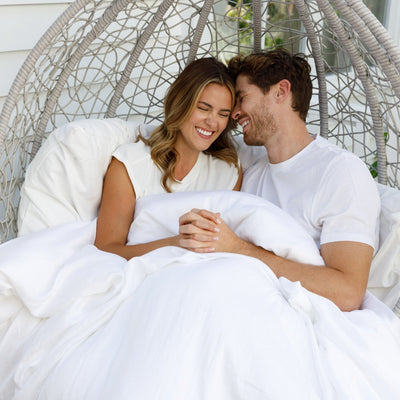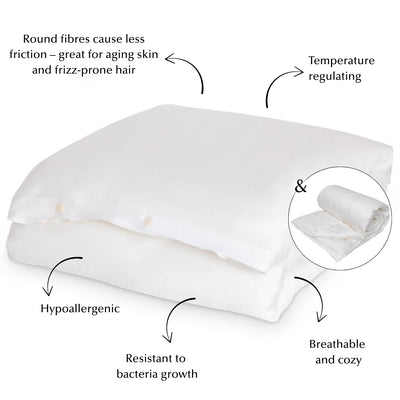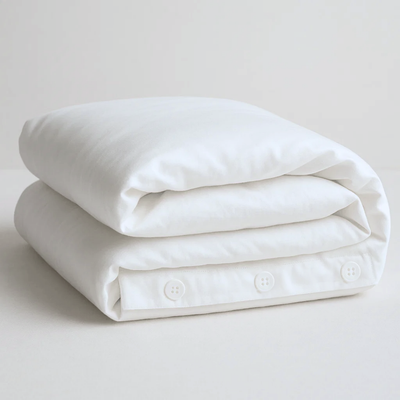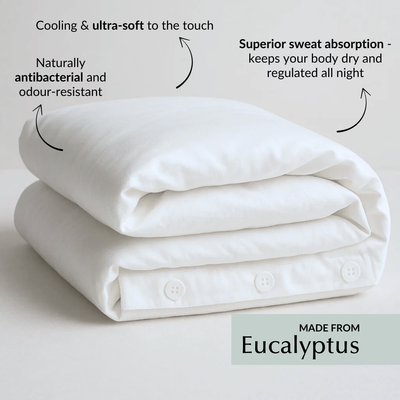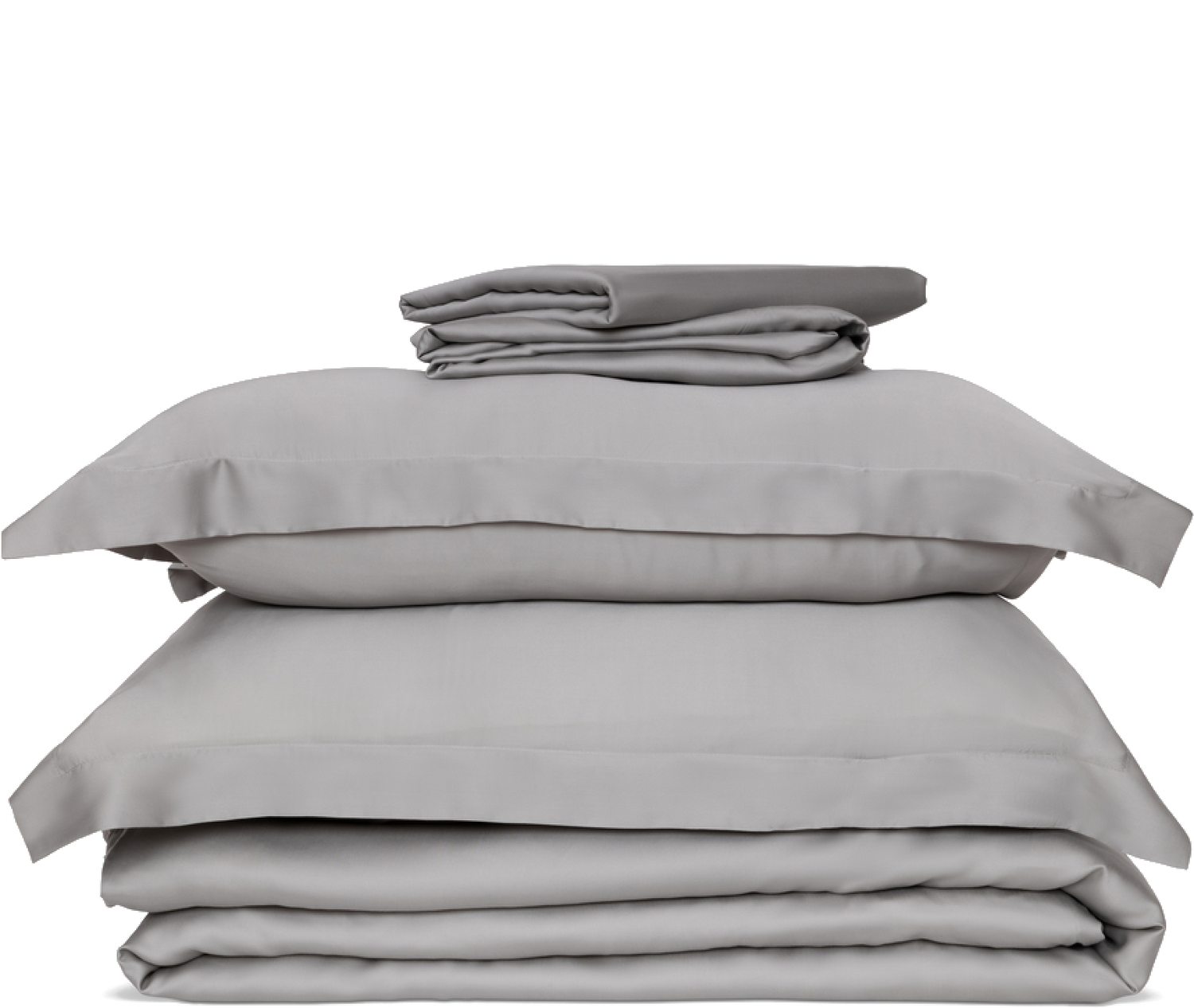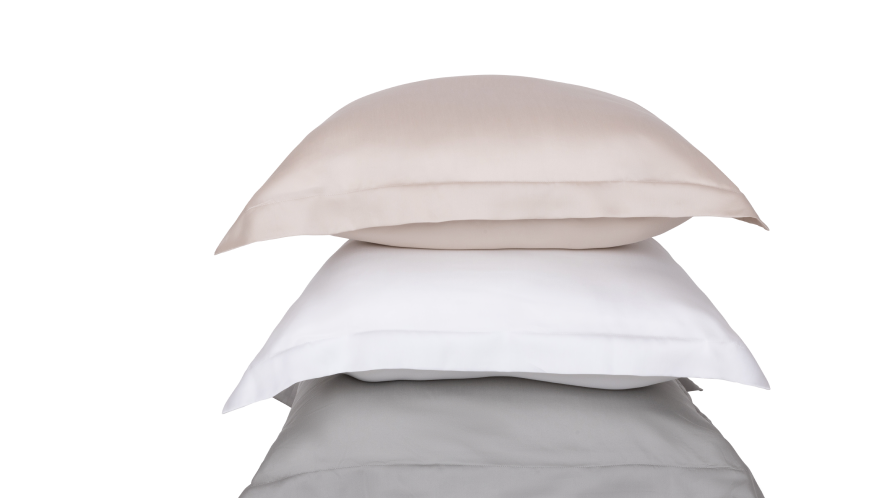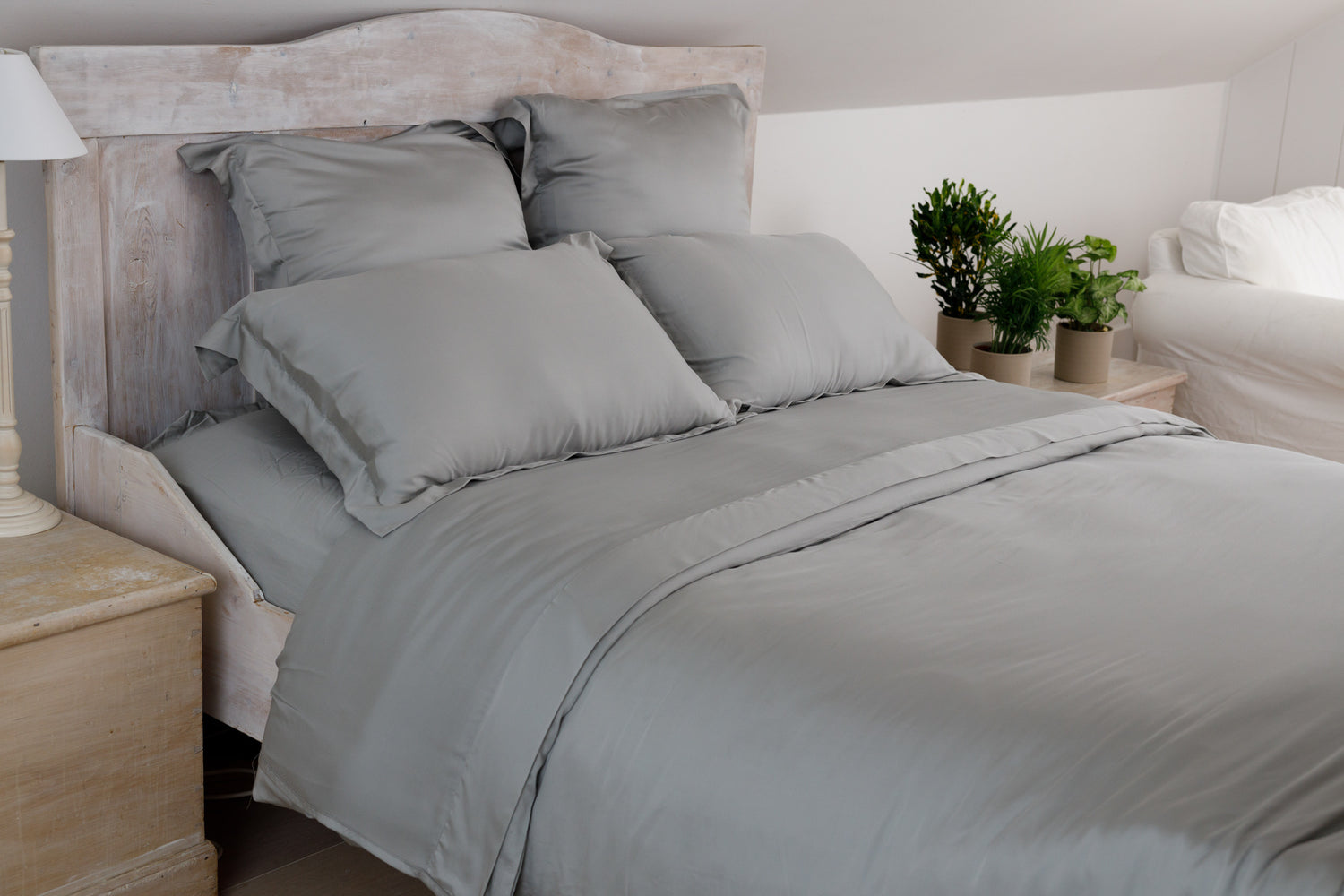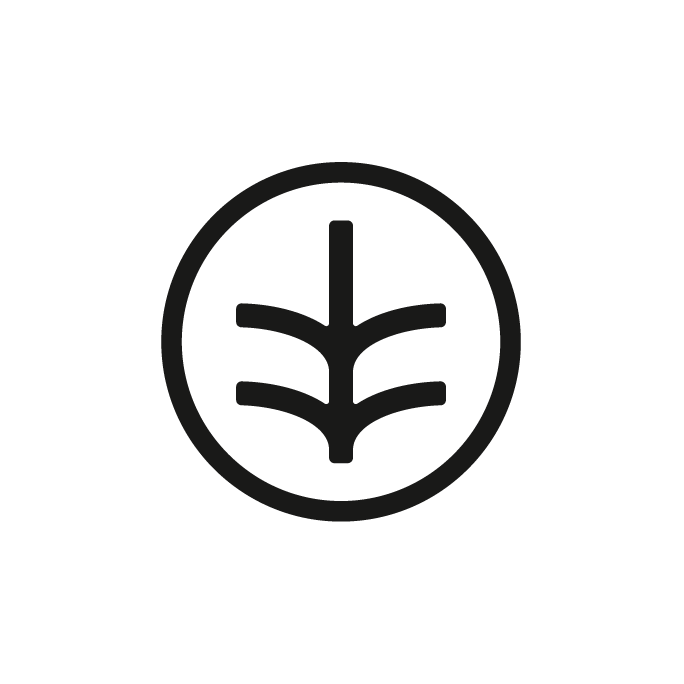When buying a new duvet, it’s important to consider a series of factors, including type of duvet filling. But which duvet filling is best?
In this article, we’ve looked at the different duvet filling types, exploring the benefits of each, considered the environmental impact of different fillings, outlined the things to look out for when buying a new duvet, and provided a handy comparison guide to help you choose your next duvet.
Natural duvet filling types
With so many types of duvet to choose from, it can sometimes be tricky to know which filling is best-placed to offer a comfortable and luxurious night’s sleep. To help you pick out the best duvet, we’ve outlined each of the most popular natural fillings, as well as their benefits and drawbacks.
Duck down and feather duvet
Duck feathers and down are sourced from the chest and belly of the bird, with the duvets favoured for their plumpness, comfort, and availability at an affordable rate.
While boasting great warmth and cosiness, the breathability of duck feathers also ensures you’re unlikely to overheat at night, making them ideal all year round! Additionally, feathers and down are fully biodegradable, meaning these types of duvet filling are completely sustainable.
However, despite the low impact on the environment, down and feather duvets can be controversial, because the filling is of course sourced from animals; in this case ducks. So, while they might be a popular pick, thanks to the advantages outlined above, it’s completely understandable that duck feather duvets aren’t for everyone!
Goose down and feather duvet
Goose down and feather duvets are another popular pick among Brits, with these types of duvet offering luxurious lightness and breathability, efficient insulation, and impressive longevity, meaning you can keep the same duvet for years and years. And, while they’re a little more expensive than duck feather duvets, they offer improved warmth and softness.
There are a few common types of goose feather, so make sure to do your research and compare the warmth, heat retention, and quality of each to determine the best duvets for your own preferences.
However, while there are numerous practical advantages to choosing these types of duvet, similarly to duck feather, goose feather and down duvets aren’t always an ethical option, due to the nature of how the filling is sourced.
Wool-filled duvet
Wool duvets are generally made with carded wool, to provide a comfortable quilt that takes on a relatively flat profile. This also means that the filling is evenly distributed, so you won’t struggle with duvet lumps and bumps.
Because the filling is carded, wool duvets often feel a little denser than alternative options, which, while you won’t get the fluffy feel you may find with feathers, does make wool one of the best types of duvet if you’re hoping for a weightier solution that drapes over you as you drift off.
Interestingly, despite the perceived weightiness, a wool duvet is efficient at heat regulation, helping you to find comfort whether you’re someone who struggles with hot or cold at night. As well as this, wool is naturally hypoallergenic, durable, and recyclable, meaning you can enjoy your duvet for years, before discarding it ethically and sustainably.
Silk-filled duvet
Silk duvets might be a little less common than wool and cotton, but the luxury feel makes them a firm favourite among Brits looking to combine comfort with chic style. While silk duvets can be more expensive than other quilt options, further benefits include their lightweight and durable formation, hypoallergenic properties, and effective temperature regulation.
Generally filled with carded silk, silk-filled duvets appear flat and compact for an evenly-distributed quilt that won’t lump up at the ends. However, one thing to be aware of is that your silk-filled duvet may lose many of its naturally soft properties if over-washed.
Cotton-filled duvet
When you see a cotton duvet, it’s likely that the filling is carded cotton sewn into a cotton outer case. Similar to silk and wool, this means that cotton-filled duvets are flatter and denser than feathery alternatives, and not at all fluffy.
Rather than a weightless cloud, a cotton duvet is more like a padded quilt that comfortably drapes over you as you get cosy at night. Considered one of the best duvet filling types for hotter climates, cotton is a lightweight solution that keeps you cool even on the sweatiest summer nights.
Linen-filled duvet
In the same way that cotton, silk, and wool-filled duvets are flat rather than fluffy, so are linen duvets. A lightweight fabric that’s hardwearing and easily cared for, linen is a popular material for summer duvets, allowing you to get cosy at night without overheating.
However, that’s not to say you can’t enjoy a linen-filled duvet all year round; an effective temperature regulator, linen is also able to keep you warmer as the weather starts to get a little colder. Other benefits of linen include its antimicrobial, hypoallergenic, and moisture-wicking properties, meaning you can enjoy a fresher night’s sleep, while its beautiful, textured finish will enhance any bedroom’s aesthetic.
Synthetic duvet filling types
Natural duvet fillings aren’t the only option on the market, with synthetic solutions also available – and often at a much more affordable price. To help you decide whether synthetic duvet filling is right for you, we’ve outlined the benefits and drawbacks of the two most popular types: microfibre and hollowfibre.
Microfibre duvet
Microfibre duvet filling is made from fine polyester, with threads that are thinner than hair. It’s essentially manufactured to be the man-made equivalent to down, and, while it can match it’s soft silkiness, it’s not quite as breathable and is far less durable.
However, microfibre is much easier to mass-produce than authentic alternatives, and in turn much cheaper to buy. Because of the way it’s manufactured, though, it’s difficult to dispose of this synthetic material responsibly, as the plastic fibres will take hundreds of years to break down, and can end up polluting the earth and oceans if dumped in landfill.
Hollowfibre duvet
Hollowfibre duvet filling is similar to microfibre, except each synthetic strand has a hole down the centre. The advantage of this is that hollowfibre-filled duvets are more effective than microfibre quilts at trapping air, which provides a softer and fluffier sleeping experience.
Why choose a bamboo-filled duvet?
We’ve looked at some of the most popular types of duvet filling, but what about an alternative solution that combines comfort with sustainability? We’ve outlined the benefits of bamboo bedding, and why it’s well-worth considering this natural resource.
Temperature regulation
Bamboo is among the best duvet filling types for temperature regulation, helping you to enjoy a comfortable night without overheating. The breathable, moisture-wicking make-up of our bamboo bedding is designed for perfect sleeping conditions, keeping you cool and dry, even during those scorching summer evenings.
Long-lasting
One of the properties of bamboo is that it’s incredibly durable and long-lasting, meaning your duvet will retain its quality for years to come. Not only this, but bamboo is also completely recyclable, meaning you can responsibly dispose of your duvet when you come to buy another.
Hypoallergenic
Naturally hypoallergenic, bamboo bedding is resistant to dust and mould, while the ultra-smooth fibres makes the duvet completely mite-resistant.
All-season use
Our bamboo bedding is 7.0 tog, meaning it’s the ideal solution for year-round use, keeping you comfortable whether it’s winter or summer. Rather than buying different types of duvet for each season, enjoy the benefits of bamboo whatever the weather (although if you do want to add another layer, consider a flat sheet!)
Soft and silky
Our unique duvets are filled with the optimum blend of bamboo and recycled bottles, letting you drift off into a pleasant slumber and enjoy an extra-soft and silky sleeping experience.
Ethical
One of the greatest benefits of using bamboo is that it’s a fast-growing and wholly sustainable resource. An environmentally-friendly solution, bamboo requires little water to grow, and, as a self-regenerating grass, doesn’t need much maintenance.
Compared to traditional feather bedding, our bamboo blend saves an average of 50 bottles from clogging up landfill sites, or 12 geese from live plucking, while providing the same luxurious softness you get with natural down.

What is the environmental impact of different duvet filling types?
Whether your old duvet has seen better days or you’re just upgrading your bedding for a better night’s sleep, it’s important to consider more than just comfort and aesthetic. Sure, they’re both important factors, and you certainly shouldn’t overlook them. But there’s one more factor to think about when picking out your new duvet: its environmental impact.
For instance, a cheaper duvet that’s of a lesser quality and may need replacing after just a short while is far more damaging to the environment than one you’ll love for years to come – especially if it’s non-recyclable. So, consider duvet filling types that are longer-lasting and highly durable. Alternatively, consider choosing duvet fillings that are biodegradable, so won’t leave a lasting impact on the planet, like down, feather, and wool.
At Ethical Bedding, not only are each of our bamboo-filled duvets as light and soft as silk to give you a cosy and comfortable night time experience, but they’re also always sustainably and renewably sourced to ensure minimal environmental impact.
What accreditations should you look for when comparing duvet filling types?
Whatever the reason you’re buying new bedding, it’s important to buy duvets that measure up to the highest industry standards. To give you an idea of what to look out for when choosing between quilts, we’ve picked out the most important duvet accreditations to be aware of:
NOMITE
NOMITE is an anti-allergen accreditation that signals that a product is suitable for those with house dust mite allergies. If you’re buying a down or feather duvet, in particular, you should keep a particularly close eye out for this certification.
OEKO-TEX 100
STANDARD 100 by OEKO-TEX is among the leading certifications for products that test negative for harmful substances. As such, it’s always worth checking for this label whenever you browse bedding, to ensure you’re only buying products that have been rigorously tested. This is an important part of the Ethical Bedding manufacturing process, with each of our soft and cosy duvets OEKO-TEX certified as earth-friendly.
DOWNAFRESH
DOWNAFRESH is an essential accreditation to look out for if you’re buying duvets filled with feathers or down, as it signals that the bedding complies with strict hygiene requirements and criteria. Not only this; DOWNAFRESH accreditation means none of the filling material has been washed with detergents that are harmful to the environment.
Responsible Down Standard
RSD accreditation means your down and feather duvet filling has been sourced both ethically and free of cruelty. In other words, the ducks or geese plucked for the filling weren’t subject to any unnecessary harm throughout the process. If you’re buying genuine feather or down bedding, make sure it’s approved by the RSD.
European Feather and Down Association
The EDFA is a certification that signifies the ethicality of feather- and down-filled bedding. The Association condemns live plucking, and inhumane forms of obtaining feathers, in accordance with EU animal protection laws. Of course, following the UK’s withdrawal from the EU, not all UK manufacturers are bound by the old rules, meaning it’s more important than ever to look out for accreditation that signifies responsible sourcing.
What to avoid: chemicals and plastic packaging
When buying any kind of bedding, make sure to spend the time researching whether it’s been treated responsibly. As referenced, all Ethical Bedding products adhere to OEKA-TEX regulations, which means our duvets are tested and washed in an organic and chemical-free environment.
Similarly, check whether the packaging you’ll receive upon delivery is harmful to the environment. Plastic packaging isn’t always reusable or recyclable, which means throwing it away sometimes means leaving it to pollute the earth or ocean for hundreds of years while the microplastics slowly break down.
At Ethical Bedding, all duvets will arrive in recyclable, minimalistic packaging, also made from recycled materials.
Anti-allergy bedding: which duvet filling is best?
You might consider yourself seemingly allergic to some forms of bedding, but did you know it might not be the filling that’s causing the discomfort? It’s likely to be dust mites instead.
Dust mites are generally more prevalent in synthetic materials, as the fabric weave is looser, so look for a natural duvet filling if you’re particularly susceptible; you’ll want bedding that’s cool and breathable, to ensure the mites can’t get comfortable!
If you do suffer from allergies, look out for the NOMITE symbol when buying your new bedding. This immediately highlights whether a material is suitable for people will dust mite allergies. Of course, if you’re aware of a specific allergy to certain duvet filling types, like wool, synthetics, or feathers, this should also form a key part of your decision-making process.
What duvet tog should I buy?
The term ‘duvet tog’ relates to the level of heat retention in your quilt, irrespective of duvet filling types, with a standardised scale of togs suitable for different sleep conditions. These range from light, summer-friendly duvets with tog ratings of 4.5 through to very warm quilts that combat the winter weather with tog ratings of 10.5+.
However, in the temperate UK, we very rarely experience either the extreme hot or cold evenings that might warrant dedicated duvets, and having multiple quilts can become expensive. Instead, you might want to consider choosing an all-seasons duvet that combines the benefits of both, keeping you warm on chilly evenings but comfortable in the height of summer.
For more advice on choosing the best tog duvet the perfect night’s sleep, check out our tog duvet guide.

Shop Ethical Bedding's Organic Bamboo-filled Duvet
What size duvet do I need?
The size of duvet you’ll need will depend on the dimensions of your mattress, ranging from single to emperor. Generally, the length of each type of duvet will remain the same – a single bed is 6’3” while an emperor is 6’6” - with the big difference in size coming when comparing widths.
As a minimum, you’ll need a duvet that completely covers your bed to keep you comfortably cosy at night, but you may want to scale up if you sleep alongside your partner and often find yourself tussling for the quilt!
For more information around choosing between different types of duvet size, check out our handy bed size guide.
What’s the best duvet filling?
There are two main categories of duvet filling, natural and synthetic, with each offering a particular set of benefits. However, there are various materials that fall under each category, that can sometimes be difficult to choose between.
To make it easy for you to decide which type of duvet filling to buy, we’ve compared each side-by-side in an easily-digestible table, taking temperature regulation, breathability, ease of care, average price, longevity, filling weight, and loftiness into account.
Each factor is scored out of five:
|
TEMPERATURE REGULATION |
BREATHABILITY |
EASE OF CARE |
PRICE RANGE |
LONGEVITY |
FILLING WEIGHT |
LOFTINESS |
|
|
BAMBOO |
4 |
4 |
4 |
4 |
5 |
2 |
2 |
|
FEATHER |
2 |
2 |
2 |
2 |
3 |
2 |
2 |
|
DOWN |
4 |
2 |
1 |
5 |
5 |
1 |
3 |
|
FEATHERS AND DOWN |
3 |
2 |
1 |
3 |
3 |
2 |
3 |
|
WOOL |
3 |
3 |
2 |
3 |
4 |
3 |
1 |
|
COTTON |
1 |
4 |
2 |
2 |
3 |
2 |
1 |
|
SILK |
1 |
4 |
2 |
4 |
5 |
2 |
1 |
|
LINEN |
1 |
4 |
2 |
3 |
3 |
1 |
1 |
|
HOLLOWFIBRE |
3 |
1 |
4 |
1 |
1 |
1 |
2 |
|
MICROFIBRE |
3 |
1 |
4 |
1 |
1 |
2 |
2 |
Of course, ultimately, the type of duvet filling you choose is entirely dependent on your own preferences, but there’s no denying that bamboo is objectively the most effective.
Not only can you benefit from effective temperature regulation, comfortable breathability, and long-lasting life, all of which make bamboo a sound investment, but you’ll also reduce your carbon footprint and contribute to sustainable practices.
When it comes to choosing a new duvet, it’s important to consider an array of factors, including comfort and eco-friendliness. Achieving both in spades with bamboo, why not explore our complete range of ethical bedding. Or for even more useful insight from our passionate bedding experts, check out the latest over on our blog.

